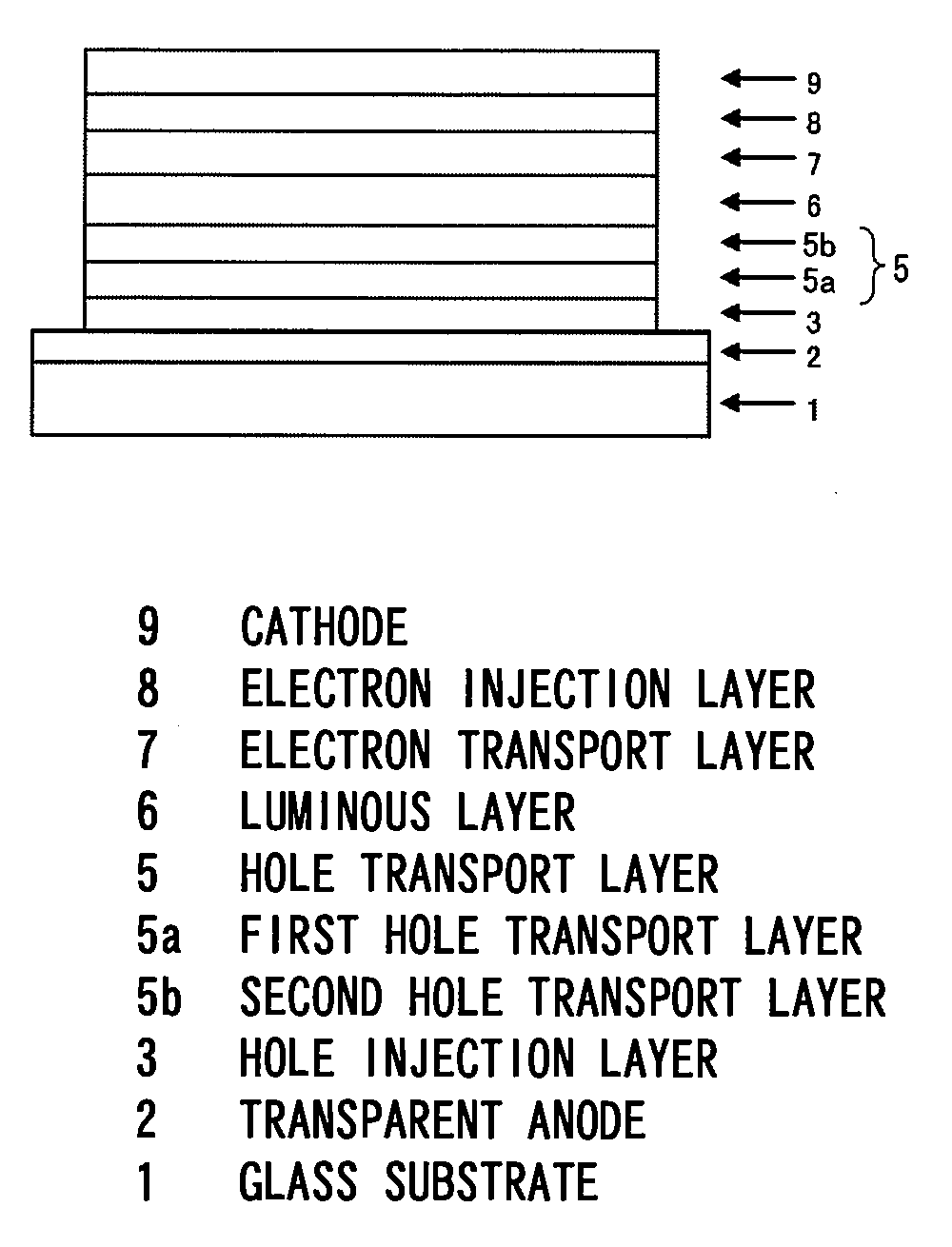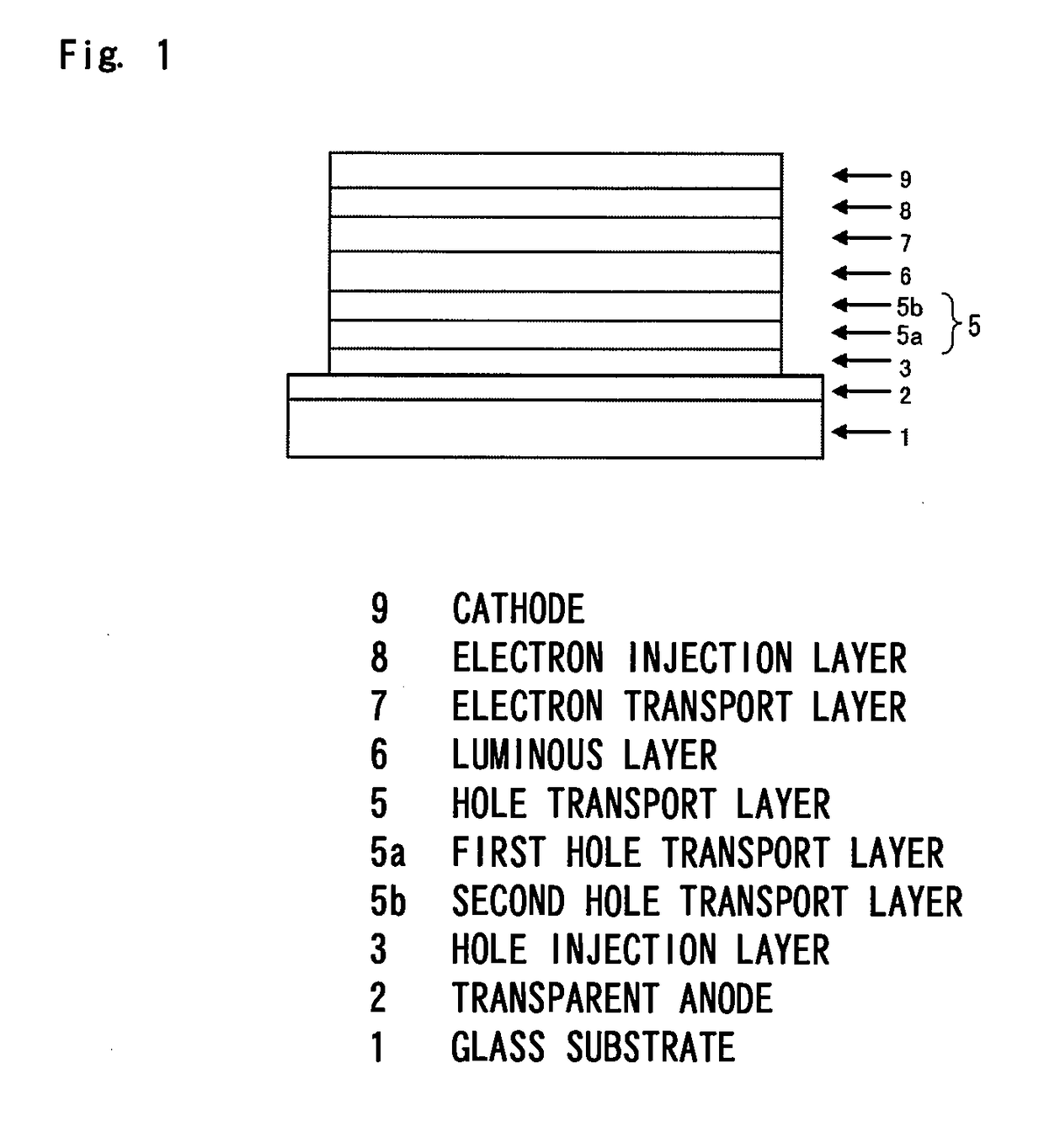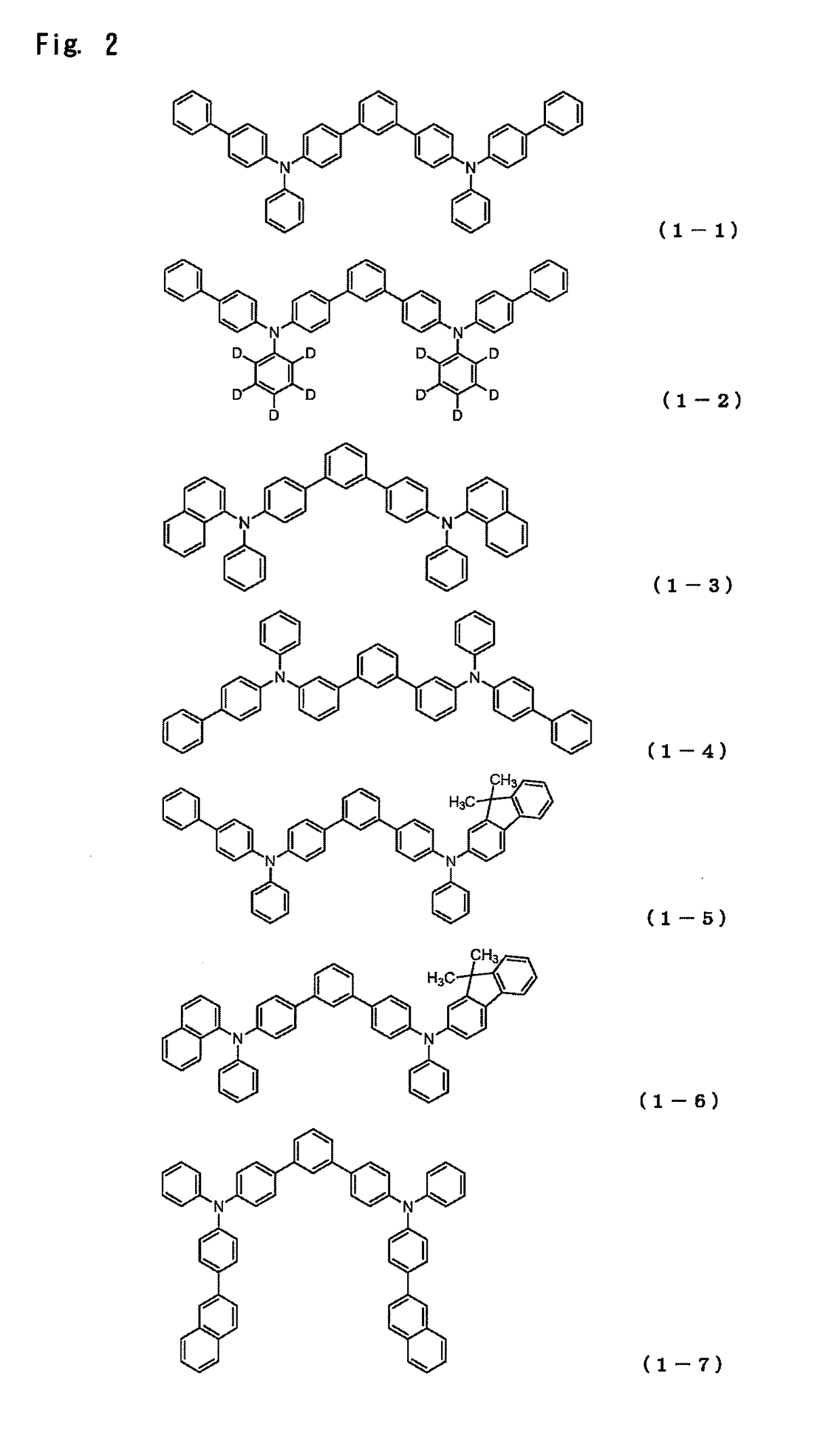Organic electroluminescent device
a technology of electroluminescent devices and organic materials, which is applied in the direction of organic chemistry, triarylamine dyes, luminescent compositions, etc., can solve the problems of material deterioration, low heat resistance, and confinement of excitons generated within the luminous layer, and achieve excellent luminous efficiency, excellent luminous efficiency, and excellent luminous efficiency.
- Summary
- Abstract
- Description
- Claims
- Application Information
AI Technical Summary
Benefits of technology
Problems solved by technology
Method used
Image
Examples
synthesis example 1
[0349]Synthesis of 4-{(biphenyl-4-yl)-phenylamino}-4″-{(9,9-dimethyl-9H-fluoren-2-yl)-phenylamino}-1,1′:3′,1″-terphenyl:
A nitrogen-purged reaction vessel was charged with 8.0 g,N-(biphenyl-4-yl)-N-(4-bromophenyl)anilineN-(9,9-dimethyl-9H-fluoren-2-yl)-N-{3′-(4,4,5,5-11.4 g,tetramethyl-[1,3,2]dioxaboran-2-yl)biphenyl-4-yl}anilinepotassium carbonate 7.5 g,water 64 ml,toluene 64 ml,ethanol 16 ml,andtetrakis(triphenylphosphine)palladium 0.8 g.
The charge was heated, and stirred for 16 hours at 70° C. to prepare a mixture. The mixture was cooled to room temperature, and ethyl acetate and water were added, whereafter an organic layer was collected by liquid separation. The organic layer was concentrated, and then subjected to recrystallization using a THF / acetone mixed solvent. As a result, 9.54 g (yield 69%) of 4-{(biphenyl-4-yl)-phenylamino}-4″-{(9,9-dimethyl-9H-fluoren-2-yl)-phenylamino}-1,1′:3′,1″-terphenyl (Compound 1-5) was obtained as a white powder.
[0350]In connection with the r...
synthesis example 2
[0351]Synthesis of 4-{(9,9-dimethyl-9H-fluoren-2-yl)-phenylamino}-4″-{(naphthalen-1-yl)-phenylamino}-1,1′:3′,1″-terphenyl:
[0352]Reactions were performed under the same conditions as in Synthesis Example 1, except that[0353]N-(3′-bromobiphenyl-4-yl)-N-(naphthalen-1-yl)aniline was used instead of[0354]N-(biphenyl-4-yl)-N-(4-bromophenyl)aniline,
and[0355]4-{N-(9,9-dimethyl-9H-fluoren-2-yl)-phenylamino}-phenylboronic acid
was used instead of[0356]N-(9,9-dimethyl-9H-fluoren-2-yl)-N-{3′-(4,4,5,5-tetramethyl-[1,3,2]dioxaboran-2-yl)biphenyl-4-yl}aniline.
As a result, 7.88 g (yield 62%) of 4-{(9,9-dimethyl-9H-fluoren-2-yl)-phenylamino}-4″-{(naphthalen-1-yl)-phenylamino}-1,1′:3′,1″-terphenyl (Compound 1-6) was obtained as a light yellowish white powder.
[0357]In connection with the resulting light yellowish white powder, its structure was identified using NMR. In 1H-NMR (CDCl3), the following signals of 42 hydrogens were detected:
δ(ppm)=7.98(1H)7.92(1H)7.84-7.75(2H)7.70-6.94(32H)1.49(6H)
synthesis example 3
[0358]Synthesis of 3,3″-bis{(biphenyl-4-yl)-phenylamino}-1,1′:4′,1″-terphenyl:
A nitrogen-purged reaction vessel was charged with6.20 g,1,4-dibromobenzeneN-(biphenyl-4-yl)-N-{3-(4,4,5,5-tetramethyl-25.1 g,[1,3,2]dioxaboran-2-yl)phenyl}anilinepotassium carbonate10.8 g,water 39 ml,toluene 380 ml,andethanol 95 ml.
With the charge being ultrasonically irradiated for 30 minutes, a nitrogen gas was passed therethrough to prepare a mixture. To the mixture, tetrakis(triphenylphosphine)palladium (0.95 g) was added, and the system was heated and refluxed for 18 hours with stirring. Then, the mixture was cooled to room temperature, 200 ml of water and 190 ml of heptane were added, whereafter the resulting precipitate was collected by filtration. The precipitate was dissolved with heating in 1,200 ml of 1,2-dichlorobenzene, and the solution was subjected to adsorption purification using 39 g of silica gel, and then to adsorption purification using 19 g of activated clay. Then, 725 ml of methano...
PUM
| Property | Measurement | Unit |
|---|---|---|
| Volume | aaaaa | aaaaa |
| Volume | aaaaa | aaaaa |
| Volume | aaaaa | aaaaa |
Abstract
Description
Claims
Application Information
 Login to View More
Login to View More - R&D
- Intellectual Property
- Life Sciences
- Materials
- Tech Scout
- Unparalleled Data Quality
- Higher Quality Content
- 60% Fewer Hallucinations
Browse by: Latest US Patents, China's latest patents, Technical Efficacy Thesaurus, Application Domain, Technology Topic, Popular Technical Reports.
© 2025 PatSnap. All rights reserved.Legal|Privacy policy|Modern Slavery Act Transparency Statement|Sitemap|About US| Contact US: help@patsnap.com



